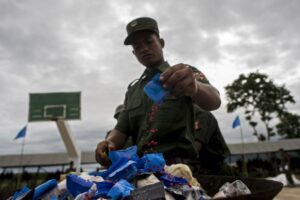In 2019, an incident in Sailulak, a village in northeastern India close to Myanmar, revealed the extent of Asia’s methamphetamine crisis.
Locals found a substantial meth stash hidden under dried red chilies, marking a significant discovery in the ongoing battle against drug trafficking from Myanmar.
This event underscored the country’s role as a major source of inexpensive meth.
The problem is exacerbated by internal conflict and the breakdown of law and order following the military coup in February 2021.
Myanmar’s turmoil has led to increased meth production, especially in the northern Shan state, renowned as a hub for narcotics.

This surge is partly due to Myanmar’s strategic position within the “Golden Triangle,” a notorious region for drug production.
Authorities in East and Southeast Asia seized a staggering 150,000 kilograms of meth in 2022, highlighting the vast scale of the problem.
Meth’s accessibility broadened its user base, with laborers, truck drivers, farmers, and students turning to it for stimulation.
The Meth Trade: A Catalyst for Conflict and Crisis
The meth trade not only presents severe health risks but also fuels further conflict within Myanmar, serving as a significant revenue source for various factions.
The situation in Laos, a neighbor of Myanmar, mirrors the broader regional crisis.
With meth prices hitting record lows due to the oversupply, the drug has become more accessible than basic necessities, trapping many in cycles of addiction.
Efforts by local rehabilitation centers, such as the Transformation Center in Vientiane, highlight the human toll of the epidemic.
Myanmar’s meth epidemic highlights the interplay between political instability, economic hardship, and the global drug trade.

